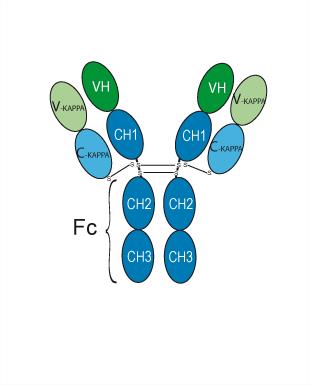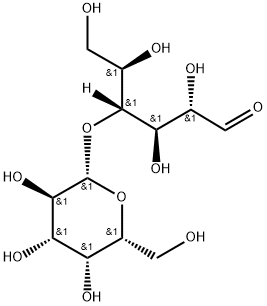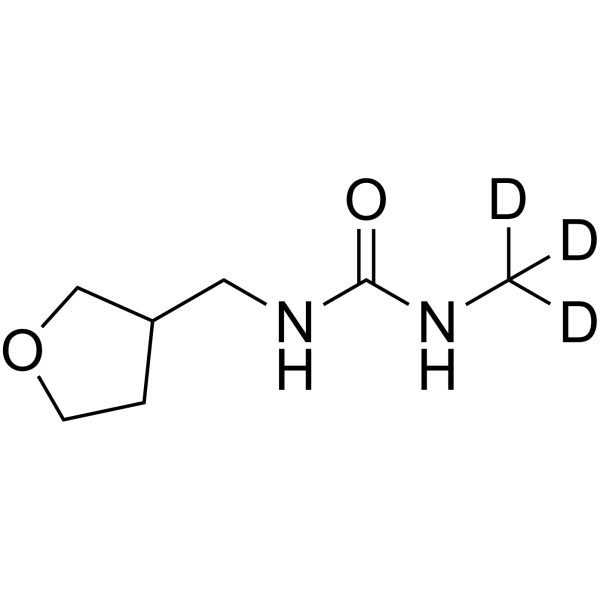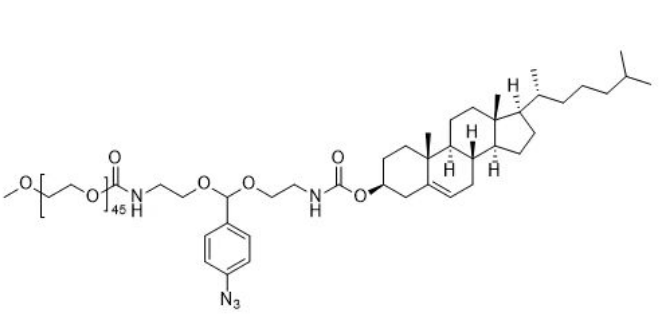| A055 |
Afelimomab Biosimilar (Anti-TNFSF2 / TNFa Reference Antibody)
Featured
|
Afelimomab (MAK 195F) is an anti-tumor necrosis factor F(ab')2 monoclonal antibody fragment. Afelimomab can be used for the research of sepsis. |
.png)
|
| A056 |
Agensys patent anti-158P1D7 Biosimilar (Anti-158P1D7 Reference Antibody)
Featured
|
|

|
| A057 |
Numab patent anti-HSA Biosimilar(Anti-Albumin Reference Antibody)
Featured
|
|

|
| A058 |
Birtamimab Biosimilar (Anti-Amyloid Alpha Reference Antibody)
Featured
|
Birtamimab (NEOD001) is an investigational monoclonal antibody that specifically and selectively target and clear the amyloid. Birtamimab can be used for the research of light chain amyloidosis. |

|
| A059 |
Mirzotamab Biosimilar (Anti-B7-H3 / CD276 Reference Antibody)
Featured
|
Mirzotamab is an IgG1κ monoclonal antibody targeting to CD276/B7-H3 with anti-tumor activity. Mirzotamab conjugates with Clezutoclax (HY-137774), a BCL inhibitor to form Mirzotamab clezutoclax (HY-P99741), involving in research with taxane research in relapsed/refractory solid tumors. Mirzotamab clezutoclax (ABBV-155) is a targeted antibody drug conjugate (ADC). |
.png)
|
| A060 |
Cantuzumab Biosimilar (Anti-CanAg Reference Antibody)
Featured
|
Cantuzumab is a monoclonal antibody that can binds the CanAg antigen. Cantuzumab is typically linked to one of several cytotoxic agents, yielding antibody-drug conjugates (ADC), such as Cantuzumab mertansine (HY-P99492) and Cantuzumab ravtansine (HY-P99493). |

|
| A061 |
VLST-002 Biosimilar (Anti-CCL5 / RANTES Reference Antibody)
Featured
|
|

|
| A062 |
R707 Biosimilar (Anti-CCR7 / CD197 Reference Antibody)
Featured
|
|

|
| A063 |
Ofatumumab Biosimilar (Anti-CD20 Reference Antibody)
Featured
|
Ofatumumab is a fully human anti-CD20 monoclonal antibody that induces antibody-dependent cell-mediated cytotoxicity and complement-dependent cytotoxicity in CD20-expressing B lymphocytes. |
.png)
|
| A064 |
Genefrontier patent anti-CD69 Biosimilar (Anti-CD69 Reference Antibody)
Featured
|
|

|
| A065 |
KHK-2898 Biosimilar (Anti-CD98 Reference Antibody)
Featured
|
|

|
| A066 |
CergutuzumAb Biosimilar (Anti-CEACAM5 / CEA / CD66e Reference Antibody)
Featured
|
|

|
| A067 |
Immunomedics patent anti-CEACAM5 (Class III) Biosimilar (Anti-CEACAM5 / CEA / CD66e Reference Antibody)
Featured
|
|

|
| A068 |
IMAB027 Biosimilar (Anti-CLDN6 Reference Antibody)
Featured
|
IMAB027 (ASP1650) is a specific anti-CLDN6 mAb, while CLDN6 (Claudin 6) is a tight junction membrane protein, aberrantly expressed in various human cancer types, ovarian cancers particularly. IMAB 027 shows anti-tumor activity, and induces apoptosis in CLDN6+ ovarian and testicular cancer cell lines. |

|
| A069 |
AB1-11 Biosimilar (Anti-CLDN6 Reference Antibody)
Featured
|
|

|
| A070 |
IM-301 Biosimilar (Anti-CLDN6 Reference Antibody)
Featured
|
|

|
| A071 |
lendalizumab Biosimilar (Anti-Complement C5 Reference Antibody)
Featured
|
|

|
| A072 |
Nurulimab Biosimilar (Anti-CTLA-4 / CD152 Reference Antibody)
Featured
|
Nurulimab (BCD-145) is an anti-cytotoxic T lymphocyte antigen-4 (anti-CTLA-4) human monoclonal antibody. Nurulimab can be can be used in research of melanoma. |
.png)
|
| DC66645 |
Epilactose
Featured
|
|

|
| DC66646 |
Dinotefuran UF
Featured
|
Dinotefuran UF is the deuterium labeled γ-Tocotrienol. γ-Tocotrienol is an active form of vitamin E |

|
| DC66647 |
ICA-1S
Featured
|
ICA-1S is a potent, specific inhibitor of Protein Kinase C-iota (PKC-ι), does not inhibit PKC-ζ, the closely related atypical PKC family member. |

|
| DC60638 |
Acid-degradable PEG Lipid (ADP-2k)
Featured
|
Acid-degradable PEG Lipid (ADP) composed of polyethylene glycol lipid is synthesized with the azido-acetal linker and used to generate RD-LNPs, which significantly improves the performance of LNP-mRNA complexes in vitro and in vivo. |

|
| DC60639 |
Acid-degradable Anionic Lipid (ADA)
Featured
|
ADA (Acid-Degradable Anionic Lipids) is revolutionizing mRNA delivery with its unique azido-acetal linker, enabling rapid hydrolysis in endosomes (pH ~6.0). This breakthrough technology ensures efficient endosomal escape, significantly enhancing mRNA delivery to target cells. ADA-LNPs excel in delivering mRNA to the spleen and liver, making them ideal for immune-related therapies.By degrading into biocompatible byproducts, ADA minimizes long-term tissue persistence and toxicity.ADA-LNPs outperform traditional LNPs, delivering mRNA more effectively to immune cells like macrophages and B cells. |
.png)
|
| DC60640 |
LI-3948
Featured
|
LI-3948 is a blood-brain barrier penetrant inositol hexakisphosphate kinase (IP6K) inhibitor with IC50 of 16 nM and brain/plasma ratio of 1.3, respectively. |

|
| DC66648 |
CP-LC-1143
Featured
|
Lipid CP-LC-1143 is an ionizable cationic amino lipid derived from homocysteine, a naturally occurring amino acid. This lipid has demonstrated an efficient delivery and high protein expression of different kinds of RNA (mRNA, cRNA and saRNA) in vivo, with no signs of toxicity. |

|
| A073 |
Antitope patent anti-CTLA4 Biosimilar (Anti-CTLA-4 / CD152 Reference Antibody)
Featured
|
|

|
| A074 |
Tremelimumab Biosimilar (Anti-CTLA-4 / CD152 Reference Antibody)
Featured
|
Tremelimumab (Ticilimumab) is a fully human monoclonal antibody specific for cytotoxic T-lymphocyte antigen-4 (CTLA-4) and can be used for metastatic melanoma research. |
.png)
|
| A075 |
Vunakizumab Biosimilar (Anti-CTLA-8 / IL-17a Reference Antibody)
Featured
|
Vunakizumab (Anti-Human IL17A Recombinant Antibody) is a recombinant human IgGκ monoclonal antibody that targets IL-17A and inhibits its interaction with the IL-17 receptor. Vunakizumab can be used to study autoimmune diseases such as psoriatic arthritis, ankylosing spondylitis, multiple sclerosis and inflammatory arthritis. |
.png)
|
| A076 |
Perakizumab Biosimilar (Anti-CTLA-8 / IL-17a Reference Antibody)
Featured
|
Perakizumab (RG4934) is a humanized IgG1κ monoclonal antibody against IL-17A (Interleukin Related). Perakizumab can be uesd for the research of autoimmune diseases, such as psoriatic arthritis. |
.png)
|
| A077 |
Netakimab Biosimilar (Anti-CTLA-8 / IL-17a Reference Antibody)
Featured
|
Netakimab is an anti-IL-17 monoclonal antibody. Nerelimomab can be used for research of ankylosing spondylitis, psoriatic arthritis, moderate-to-severe plaque psoriasis. |
.png)
|
.png)



.png)



.png)








.png)



.png)



.png)
.png)
.png)
.png)